
Contributing Writer
Massive budgets and the enviably simple target of winning at all costs - we all know what motivates the top teams in Formula One. But what about the small, privately owned squads that, in the eyes of many, are just there to make up the numbers? What is it that makes them stay in this uncharitable environment for season after tough season, without even the chance of ever getting into the limelight? Journalist Peter Farkas looks at the teams that have never managed to make it to safer territory
In the days when privateers could freely buy cars from constructors, entering them to Grands Prix on a regular or occasional basis, it was not unusual to see a driver or a team getting onto the grid and then disappearing into the history books right after. But there are also more recent examples of stillborn Formula One teams.
In 1997, after only three months of "serious" preparation, Eric Broadley tried to bring back the once famous Lola name into the sport, but disaster duly struck when his drivers, Ricardo Rosset and Vincenzo Sospiri, both failed to qualify for the season-opener in Melbourne. Obviously the scheme of getting two inexperienced drivers (Rosset had 16 starts with Footwork under his belt, whereas Sospiri was a complete rookie) into a hastily tailored car did not work, and the team's main sponsor Mastercard had withdrawn its backing before the next race in Brazil.
If we regard Broadley's plans as a bit too optimistic, it's hard to find the right word to describe Willibald Kauhsen's Formula One attempt. This former sportscar racer appearently decided to enter his cars into the elite category of motorsport after he found that the F2 series was too difficult for him. He bought a couple of championship-winning Elf 2J chassis at the end of 1976 and tried to run them in F2 without much success.
And the list of stillborn attempts just goes on and on. New Zealander Chris Amon, probably the most talented Formula One driver never to have won a race, tried to build his own car, the Amon-Ford AF101 for the 1974 season, after he couldn't get a proper drive. Amon qualified 23rd in the first European round at Jarama, but he couldn't finish the race because of mechanical problems. That was the start of the end, since Amon never made it onto the grid afterwards, and Larry Perkins, who was given a chance to try the car, also failed to qualify it for the Italian Grand Prix. Amon got into financial troubles after his team was closed down, and although he recovered and continued racing for two more years, he couldn't add to his list of five pole positions.
When a team that never really was goes down the trapdoor it's unsurprising; to see a once well-established and successful marque joining the list of the deceased is somewhat more distressing. Still, the truth is that, apart from Ferrari, none of the teams that took part in the 1950 season are on the grid today. Names like Benetton, Brabham, BRM, Cooper, Lotus, March, Tyrrell, Maserati and Ligier, all part of the Formula One folklore, have all met this fate. Some, such as Benetton or Stewart, left peacefully, getting new identities but living on in vigour and enjoying success during their new life. Most of the others, however, have gone away after a long mortal agony. If it's not easy for a driver to end his career on the top, it's an even more difficult thing to do for a team.
Lotus for example, still only behind Ferrari, McLaren and Williams in terms of Grand Prix victories with 79 wins, went down the order after its founder, Colin Chapman died of a heart attack in 1982. Under the guidance of new team boss Peter Warr, Ayrton Senna scored Lotus' last success at the 1987 Detroit GP, but from then on they struggled to keep up with the others.
The most recent casualty is, of course, Arrows Grand Prix, a team that, during its 25-years long history, never managed to win a race. Although from 1991 to 1996 they were called Footwork, they were essentially the same team, and taking this into consideration Arrows is the longest-serving marque without a race win in the history of Formula One. (Although some would argue this record belongs to Minardi, since the small Italian squad have had 303 Grand Prix starts, while there were only 295 races where the Arrows name appeared on the list of the entrants).
Whatever the case, for Arrows the end was just as troubled as the beginning. The team has been formed by a breakaway group of five people from Shadow in 1977, and although Riccardo Patrese went on to finish third at Long Beach, just the third race of the 1978 season, his car, the FA/1, was soon pulled out of service because of copyright infringements, since it was obviously the copycat of the Shadow DN9. Arrows had been on the pace far from the track, in its Milton Keynes factory however, and barely a day after the High Court in London ruled they should not use the FA/1, its successor, the A1 - which has been produced in just 52 days - made it onto the track.
The team, later moving to Leafield when Scotsman Tom Walkinshaw acquired a controlling interest in it, probably had its most glorious days in 1997. Damon Hill, bringing the beautiful "Number 1" with him from Williams as reigning World Champion, almost won in Hungary after a superb drive, and he still finished second to Jacques Villeneuve when a mechanical problem slowed him down just two laps before the end.
Four years later and Arrows was in trouble; Walkinshaw proved to be too cunning for his own good, and in 2002, after making a myriad of superflous changes in the driver line-up, his team failed to turn up at a number of Grands Prix, effectively digging their own grave. They went into liquidation at the end of the year, barely a season after Prost Grand Prix had disappeared, taking the remains of the once-famous Ligier team with him.
So there are the teams that never really were; there are the teams that were once a decisive force in Formula One, but have fallen back on the grid for some reason and later disappeared from the sport; and then there are the teams that keep on going and going, season after season, despite never making any real progress in terms of points and position.
"It's just one word: passion," said Minardi boss Paul Stoddart, when asked this question during the Hungarian Grand Prix weekend last year. "Passion for racing and everything about Formula One. Minardi has seen so many teams disappearing over the years, and we are still here. It's not easy to be a small team in today's environment, particularly when you're competing against teams with this massive budget, but we do it, and we do it in a very professional way. But to do it much better than we're doing at the moment is not really possible because we don't have the budget. We do the best job we can."
Indeed they do. It's worth noting that, while they spend roughly six percent of the budget of the top teams, Minardi comes very close to them in terms of performance; the differences between Jos Verstappen's and Michael Schumacher's laptimes had fallen between 3.2 and 5.7 percent in 2003. This means that, with a 94 percent budget deficit, Minardi has lost only about 4.5 percent in speed.
Of course this is not significant in itself, since that difference may mean 19 positions on the grid between the two drivers, and no matter how the governing body tries to hold expenses at bay the top teams will probably always spend as much as they can in order to get that tiny advantage. Still, the pattern is there: if they really wanted, teams could indeed operate on a much smaller budget without the fans noticing a performance drop - Minardi is the living example of that.
But there are only three privateer teams left in Formula One, and although they usually don't mix it with the frontrunners, Stoddart thinks they are just as essential to keep the sport popular. "We've seen the end of Prost, we've seen the end of Arrows, both Minardi and Jordan have troubles. We have to do something, because ten is a very special number in F1," he said. "If we lose ten, nine does not work at all. Three times eight works, but running three cars is a sort of a problem. We need 12 teams in F1, not 10, but we most certainly do not need 9 or 8. We'll see."
Even having an official engine partner may not be enough to bring a team to the top, as the Prost-Peugeot combination effectively proved a few years ago. But it's increasingly likely that squads without manufacturer backing will not be able to stay in Formula One. The problem is carmakers not currently interested in the sport are unlikely to buy in now, until the affairs between the GPWC, SLEC and the banks are resolved. On top of that, Stoddart is in further trouble, because the dreadful terrorist attacks against New York on September 11 two-and-a half years ago have put the airline industry in an awful shape, so he can't even help Minardi through his company, European Aviation.
Not surprisingly, he would be willing to form a partnership with a car manufacturer. "Because I can't compete this way, and it'd be hard to imagine what industries you could get the sponsorship money from to compete with the manufacturers. They're putting in over two billion dollars a year between the seven of them into Formula One," he explained.
If you think pressure is less intense at the back end, think about it again. This might be true for the drivers, who don't neccessarily fall victim to worldwide media criticism after all the mistakes they make; let's face it, whether a Minardi driver finishes 11th or 12th sadly bears little interest to most of the public. But, for the team management the pressure is the same as at a top team - only the worries are different. While Frank Williams must fight both on and off the track to get as many wins and points as possible to keep his team's World Championship hopes alive, Stoddart must do the same, but the stake, for him, is even higher: to survive the season and reach the next one.
In these circumstances, a team like Minardi can't set very ambitious targets for a Grand Prix weekend. In fact, for them even scoring points is a much greater achievement than for a top team to win a race; since 1995, they've added four points to their tally in total, while during the same period Michael Schumacher won five World Championships. It's a striking difference, which also means that Minardi needs to have its own approach to racing.
"When we arrive at a Grand Prix weekend, the first thing we have a look at is what the conditions are going to be weather-wise, so we are primarily interested in the weather, because we know that given our budget and given our performance, we need things to be different," Stoddart admitted. "We need changing weather conditions; we need rain, we need rain and dryness to maximise the advantage of our tyres; there are lot of things we need to have got right to have a good weekend.
"We have to pay absolute attention to strategy, because we can't compete with the bigger teams on pure performance. In 2002 and 2001 we could rely on bad cars or drivers having a bad day. Quite often both Fernando (Alonso) and Mark (Webber) outqualified some much more funded opposition, and we had good weekends, we had good race results - for us. To qualify in the top eight teams is a good result for us, to finish a race in the top ten is a good result for us, and to score points is fantastic."
"And we were not stopping, we were going the whole race distance, as Tyrrell did in Monaco in '97; the whole race distance without fuel. And if there were enough safety car incidents, which there were, all we had to do was just wait for the others to go to the pits for fuel, and mathematically - we realised it in simulator programs - it showed Jos (Verstappen) winning instead of (Giancarlo) Fisichella. He was ahead of Fisichella when he went off on lap 31."
What Minardi can do better than top teams, however, is spotting new talents. They may not be able to afford promising drivers who don't have substantial backing, but they take less risk by signing an unproven guy. It's telling that of the 20 drivers on the 2004 Formula One grid, six are past or present Minardi drivers. The situation was even more prominent at last year's Italian Grand Prix, where (together with Marc Gené, who stood in for the injured Ralf Schumacher at Williams) no less than 40 percent of the grid have competed for Minardi during their career. Most of these guys - two of them, Fernando Alonso and Giancarlo Fisichella, already race winners - would probably not have been able to make it to the top category without Minardi.
Stoddart was obviously happy to point this out. "I believe that you probably ought to give the guys a chance in life they probably might not get otherwise for one reason or an other. So, in fairness, I think it's one of my proudest things that we do. We are a team where, if you are a driver, you come to Minardi and do well, you will go on to better teams, and I'm very proud of that."
If you consider that past or present Jordan and Minardi drivers occupy exactly half of the 2004 field, and that if you add the third privateer, Sauber, the number increases from 10 to 14 drivers out of 20, you can hardly question the importance of these small teams. They are the endangered species of Formula One, but their extinction would certainly upset the ecological equilibrum, which is, we may well remember, always a concern for the predators as well. The vole is no less important than the eagle.
If someone asked you to list all the teams that have ever participated in the World Championship since its inception in 1950, how far would you get? You would, at least if you fall into the controversial category of a "typical" Formula One fan, probably start with Ferrari, then go on to McLaren, Williams, Renault, Tyrrell, Lotus and the rest of the best. When urged to nominate more, you may mention Benetton, Jordan, Ligier, even Minardi or, if you are into the history of the sport, such teams as Brabham, BRM, March, Maserati and Cooper. But, without wanting to question your competence, there is little chance that Kauhsen, Shannon, Stebro or Fry would immediately come to your mind.
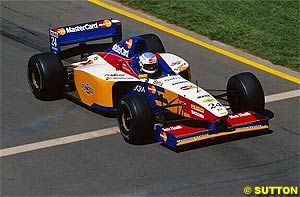 It's not your fault, of course, because the list is a long one. In fact, there have been as many as 152 teams in the 54-years long history of the Formula One World Championship (counting those that only started the races at Indianapolis as well, when it was part of the World Championship), with only 22 of them having participated in more than a hundred Grands Prix. Seven of these teams are still on the grid today, and another one - British American Racing - will join that elite club during the 2004 season. At the cheerless end of the long list, there are also 33 teams that, for whatever reason, haven't been able to start more than one race, and 46 that have never scored any points.
It's not your fault, of course, because the list is a long one. In fact, there have been as many as 152 teams in the 54-years long history of the Formula One World Championship (counting those that only started the races at Indianapolis as well, when it was part of the World Championship), with only 22 of them having participated in more than a hundred Grands Prix. Seven of these teams are still on the grid today, and another one - British American Racing - will join that elite club during the 2004 season. At the cheerless end of the long list, there are also 33 teams that, for whatever reason, haven't been able to start more than one race, and 46 that have never scored any points.
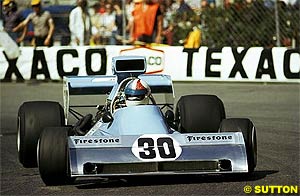 Then, for the 1979 season, he let Klaus Kapitza design an F1 car which - from the outside at least - looked very much like Colin Chapman's overly succesful Lotus 79. The only problem was, their speed didn't have much in common. When Gianfranco Brancatelli couldn't qualify the Ford-powered machine in its first two outings at Jarama and Spa, Kauhsen wisely sold it to Arturo Merzario. The car, by this time renamed the Merzario A4, finished 11th in Imola.
Then, for the 1979 season, he let Klaus Kapitza design an F1 car which - from the outside at least - looked very much like Colin Chapman's overly succesful Lotus 79. The only problem was, their speed didn't have much in common. When Gianfranco Brancatelli couldn't qualify the Ford-powered machine in its first two outings at Jarama and Spa, Kauhsen wisely sold it to Arturo Merzario. The car, by this time renamed the Merzario A4, finished 11th in Imola.
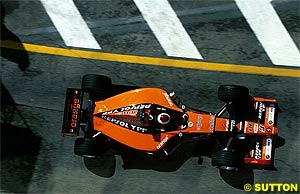 Lotus still finished 6th in their second to last season, but a year later, in 1994, they failed to score a single point despite running four seriously quick drivers: Johnny Herbert, Pedro Lamy, Alex Zanardi and Mika Salo, as well as Eric Bernard and Philippe Adams. In October David Hunt, brother of 1976 World Champion James, bought the team, but two months later he called off the project, and hence the history of Lotus was sadly over.
Lotus still finished 6th in their second to last season, but a year later, in 1994, they failed to score a single point despite running four seriously quick drivers: Johnny Herbert, Pedro Lamy, Alex Zanardi and Mika Salo, as well as Eric Bernard and Philippe Adams. In October David Hunt, brother of 1976 World Champion James, bought the team, but two months later he called off the project, and hence the history of Lotus was sadly over.
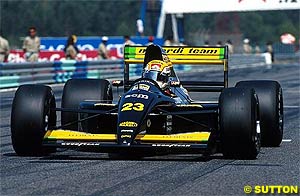 How do they put in those incredible working hours, day after day, year after year, knowing they will never be able to compete with the big guns, simply because they don't have the budget and the resources? What is it that motivates them to get back to the car after another failure to score points? Surely, the disappointment of not having reached their own modest targets is just as serious as the one people at Ferrari feel for missing out on a race win. Ferrari or Minardi, it doesn't matter; both are run by human beings with the same basic feelings. So, what's the secret?
How do they put in those incredible working hours, day after day, year after year, knowing they will never be able to compete with the big guns, simply because they don't have the budget and the resources? What is it that motivates them to get back to the car after another failure to score points? Surely, the disappointment of not having reached their own modest targets is just as serious as the one people at Ferrari feel for missing out on a race win. Ferrari or Minardi, it doesn't matter; both are run by human beings with the same basic feelings. So, what's the secret?
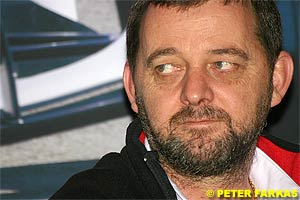 The main problem, of course, is the lack of money, but not simply in the straight sense. Not only it is harder for a small team to get decent sponsorship, but they lose a lot through having to pay for their customer engines. Minardi, for instance, spend half of their 30 million dollars or so annual budget on the Cosworth units. "When you consider that the teams we're competing against, with the exception of Sauber and Jordan, actually not only get their engines free but they also get massive sponsorship above that, it's really quite a disadvantage not to have a works manufacturer," Stoddart pointed out.
The main problem, of course, is the lack of money, but not simply in the straight sense. Not only it is harder for a small team to get decent sponsorship, but they lose a lot through having to pay for their customer engines. Minardi, for instance, spend half of their 30 million dollars or so annual budget on the Cosworth units. "When you consider that the teams we're competing against, with the exception of Sauber and Jordan, actually not only get their engines free but they also get massive sponsorship above that, it's really quite a disadvantage not to have a works manufacturer," Stoddart pointed out.
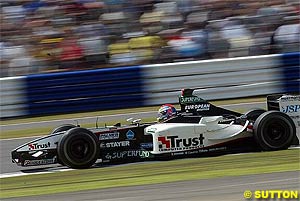 Still, last year there was actually a race Stoddart thought they could have won. "A classic example was Brazil. For the first time in 20 years Minardi went actually with the intention of winning the race," he stated. "At the fuel strategy we've relied on there not being more than 75 percent of the race run, and the strategy we've relied upon was that 50 percent of that 75 percent would be run behind the safety car to save fuel.
Still, last year there was actually a race Stoddart thought they could have won. "A classic example was Brazil. For the first time in 20 years Minardi went actually with the intention of winning the race," he stated. "At the fuel strategy we've relied on there not being more than 75 percent of the race run, and the strategy we've relied upon was that 50 percent of that 75 percent would be run behind the safety car to save fuel.
About the author:
Budapest-based journalist Peter Farkas works for the Formula One site of RTL Klub television, A5.hu, as well as Hungary's only printed publication dedicated solely to F1, Formula Magazin. He is also an occasional contributor to the Atlas F1 news section both as reporter and photographer.
| Contact the Editor |
Please Contact Us for permission to republish this or any other material from Atlas F1.
|
Volume 10, Issue 7
Articles
The Back End
CART and Sold
The Readers Digest
The Paint Job
2004 Countdown: Facts & Stats
Columns
The F1 Trivia Quiz
On the Road
Elsewhere in Racing
The Weekly Grapevine
> Homepage |